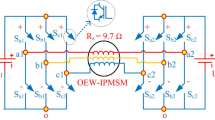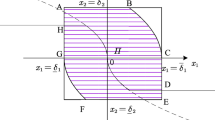Abstract
A wind energy conversion system (WECS) based on doubly fed induction generator (DFIG) and matrix converter is presented. We developed a new robust control law for the active and reactive stator powers with sensorless stator current, contrary to control methods given in the literature where all stator and rotor currents are necessary. The rotor flux and stator powers, required to control the DFIG, are determined through the proposed sliding-mode observer. Three main benefits come out of our law including robustness, low cost and the possibility of supervising the converter through rotor current measurements. Simulations of the considered WECS are carried out, for different operating points, to highlight the performances of the proposed system.














Similar content being viewed by others
References
Cheng M, Zhu Y (2014) The state of the art of wind energy conversion systems and technologies: a review. Energ Convers Manag 88:332–347
Kaplan YA (2015) Overview of wind energy in the world and assessment of current wind energy policies in Turkey. Renew Sust Energ Rev 43:562–568
Merahi F, Berkouk EM, Mekhilef S (2014) New management structure of active and reactive power of a large wind farm based on multilevel converter. Renew Energ 66:15–24
Taib N, Metidji B, Rekioua T (2013) Performance and efficiency control enhancement of wind power generation system based on DFIG using three-level sparse matrix converter. Int J Electr Power 53:287–296
Altun H, Sünter S (2012) Modeling, simulation and control of wind turbine driven doubly-fed induction generator with matrix converter on the rotor side. Electr Eng 95:157–170
Luo FL, Pan ZY (2006) Sub-envelope modulation method to reduce total harmonic distortion of AC/AC matrix converters. IEE Proc Electr Power Appl 153(6):856–863
Hu J, Xu H, He Y (2013) Coordinated control of DFIG’s RSC and GSC under generalized unbalanced and distorted grid voltage conditions. IEEE Trans Ind Electron 60(7):2808–2819
Yao J, Li H, Chen Z, Xia X, Chen X, Li Q, Liao Y (2013) Enhanced control of a DFIG-based wind-power generation system with series grid-side converter under unbalanced grid voltage conditions. IEEE Trans Power Electr 28(7):3167–3181
Zhi D, Xu L, Williams BW (2010) Model-based predictive direct power control of doubly fed induction generators. IEEE Trans Power Electr 25:341–351
Liu X, Kong X (2014) Nonlinear model predictive control for DFIG-based wind power generation. IEEE Trans Autom Sci Eng 11(4):1046–1055
Zhang Y, Hu J, Zhu J (2014) Three-vectors-based predictive direct power control of the doubly fed induction generator for wind energy applications. IEEE Trans Power Electr 29(7):3485–3500
Xu L, Cartwright P (2006) Direct active and reactive power control of DFIG for wind energy generation. IEEE Trans Energy Conver 21(3):750–758
Hu J, Zhu J, Dorrell DG (2014) Model-predictive direct power control of doubly-fed induction generators under unbalanced grid voltage conditions in wind energy applications. IET Renew Power Gen 8(6):687–695
Chwa D, Lee KB (2010) Variable structure control of the active and reactive powers for a DFIG in wind turbines. IEEE Trans Ind Appl 46:2545–2555
Susperregui A, Martinez MI, Zubia I, Tapia G (2012) Design and tuning of fixed-switching-frequency second-order sliding-mode controller for doubly fed induction generator power control. IET Electr Power Appl 6(9):696–706
Shang L, Hu L (2012) Sliding-mode-based direct power control of grid-connected wind-turbine-driven doubly fed induction generators under unbalanced grid voltage conditions. IEEE Trans Energy Convers 27(2):362–372
Djoudi A, Chekireb H, Bacha S, Berkouk EM (2014) Lower gain adaptive sliding mode control of DFIG stator powers. In: 3rd Renewable Power Generation Conference (RPG 2014), Naples, 24–25 Sept 2014. Institution of Engineering and Technology (IET). doi:10.1049/cp.2014.0887
Djoudi A, Chekireb H, Berkouk EM, Bacha S (2015) Low-cost sliding mode control of WECS based on DFIG with stability analysis. Turk J Electr Eng Comput 23(6):1698–1714
Beltran Brice, Benbouzid Mohamed, Ahmed-Ali Tarek (2012) Second-Order sliding mode control of a doubly fed induction generator driven wind turbine. IEEE Trans Energy Convers 27(2):261–269
Belmokhtar K, Doumbia ML, Agbossou K (2014) Novel fuzzy logic based sensor-less maximum power point tracking strategy for wind turbine systems driven DFIG. Energy 76:679–693
Tadjine M, Chekireb H, Djemai M (2003) On a sliding mode control and observer of induction motor. In: Proceedings of the IEEE international conference on systems, man and cybernetics, Washington, DC, 5–8 Oct 2003. IEEE, pp 1371–1377
Utkin VI (1993) Sliding mode control design principles and applications to electric drives. IEEE Trans Ind Electron 40(1):23–36
Author information
Authors and Affiliations
Corresponding author
Rights and permissions
About this article
Cite this article
Djoudi, A., Bacha, S., Chekireb, H. et al. Robust stator currents sensorless control of stator powers for wind generator based on DFIG and matrix converter. Electr Eng 99, 1043–1051 (2017). https://doi.org/10.1007/s00202-016-0468-0
Received:
Accepted:
Published:
Issue Date:
DOI: https://doi.org/10.1007/s00202-016-0468-0




